A Life In Between - on the Bellarine!
The older I get, the more I hear from friends who sicken of cities. They seek a plot with the lot, within reach of the beach, yet not too far away from all the city has to offer, just in case there is a compulsive rush for the theatre – operating or opera! By now, most people my age, have ‘got it all’ in terms of clothes and goods. We no longer want for a house with lots of rooms, or places with stairs, and now only need a garden that would suit a Lilliputian. There is no real need for rush and noise, just a place where you can skip along in your motor un-harassed by honkers or road-ragers, where you can still find parking in the main street, and a place where the coffee shops and quirky restaurants do a skinny yaks milk cappuccino, or a mean gnocchi with Bavarian goats cheese and olive oil from Puglia! Oh yes, many of the baby boomer ‘transmuters’, do like life outside the city commuting zone, that girdle belt that grips the city and forces up prices, and down, services. And which is why tiny towns in places like the Bellarine Peninsula, half an hour from Geelong, ninety minutes from Melbourne, are booming. “Hey man, its all about lifestyle” say the surfie and the pensioner, speaking the same language, both happy to wave goodbye to the Big Smoke. Besides, it is still there if they want it, but now just over the tree lined, sand duned, horizon!
In the late 1990s, a television series called “Sea Change” became Sunday night essential viewing in Australia and developed a cult following. It was all about a pent-up and scratchy city lawyer, played by the beautiful Sigrid Thornton, who takes a job as a magistrate in ‘Pearl Bay’ where the locals' sang froid forces her too, to change. People like Diver Dan, the ‘she’ll be right’ romantic attraction, who has thrown away time pieces and suits in equal measure, in that oft seen city meets country manner. It was popular, because the clash of ‘civilizations’ made us all laugh, but it also made us think! Many times in traffic, I thought, “Now if this was Pearl Bay!” Then the wise began to see change.
While the rest of Australia might dream of ‘Pearl Bay’, many others knew that the ‘real Pearl Bay’ was in fact the seaside village of Barwon Heads, where the Barwon River meets Bass Strait and the Southern Ocean. It is just one of many picturesque tiny towns on the Bellarine Peninsula, a stump of land which curls like a jutted thumb, and guards one side of the entrance of Port Phillip Bay, on which lies a distant Melbourne. The drive from Geelong is through undulating countryside, full of farmlets, with paddocks of heifers and horses, and acres of vines. Here, along little gravel and limestone ‘roadettes’, a knowing Swiss winemaker, long ago planted grapes, which kissed by an abundant sun, and wooed by salty sea breezes, today spawn superb regional wines. We traveled to Scotchman’s Hill, where the tasting room was in the converted lounge-room of a solid brick, hilltop house, with views of the distant Swan Bay and its long, golden beaches. Although as a word-smith, Browning has beaten me to it, I have no trouble in following him to say, “a pleasanter spot, you never spied!” The Pinot Noir was stunning, as light and silky as the view, the Pinot Grigio, light green, like newly cut straw, and a floral bouquet, that a perfumer might try to capture. We bought, and moved on, but only because the day was shortening and there was much to see.
We approached Barwon Heads over its famous, low-lying, all timber, bridge which through the efforts of the local citizenry has defied dismantling for a more modern concrete arch. Old settlers like the comfort of their old slippers, and they have worn the bridge for a long time. There on my left, was the limestone bluff and the jetty restaurant which was ‘Diver Dan’s place’ in Sea Change, and behind it, like soldiers in the brush, the tops of caravans and cabins full of the summer influx. Traveling north by north-west along Hitchcock St, there were wonderful cafes and psycho-idyllic hippie eateries, with enough birds and as much flair, as Alfred, Along the beach there were danglers and rodders, all trying to catch a fish, but again, given that much of Victoria was drowning in flooding, the river looked like coffee. Where it met the sea, it was like the confluence of the Rio Negro and the Amazon, an amazing sight with more black and blue than found in a Carlton footy jumper.
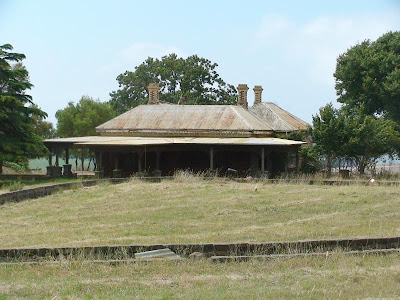
We bought a coffee at Annie’s, as good as any I had ever tasted, from a woman in shorts and a tee top, spiked blonde hair and a tongue stud, but with a ready smile and a “Yes love?” before I’d even said a thing! There on the wall was a pin up board with advertisements for “Boot Camp”, yoga, and therapeutic oil massage, while the words organic and holistic were liberally sprinkled elsewhere. There were lots of oldies sitting sipping, and young-uns too, their chattering competing with the parrots, and everywhere there were water bowls for passing Fidos. That over-used term ‘relaxed’ was not hyperbole here. But as with Paradise, Adam and Eve were soon followed by a whole lot more, so land and house prices now rival places in Melbourne. Everyone, it seems, wants a slice of Paradise.
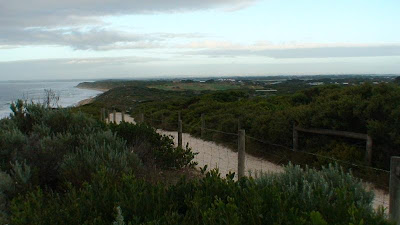
The sun’s rays gentle upon the Bluff and the Southern Ocean
The next morning when the sun tossed off the duvet, my son and I walked past one of the region’s many golf courses, already alive with old men, and followed the coastal path to the Bluff. On a beach below, they could have staged a half-marathon, such was its unimpeded length, and on our path, joggers vied with people in motorized wheel-chairs, flags fluttering at the masthead, to take in the morning air, and the views. The tang of salt was in our noses and a gentle surf came ashore, already carrying surfers, dressed like seals. That gentle surf was but the sea’s pleasant face, for this shore is not called The Shipwreck Coast for nothing. In WWI, the Germans mined these waters, successfully sinking ships, while in WWII an aircraft from a giant Japanese submarine flew along the coast, charting the fortifications and the presence of guns. And the waters are cold too, coming as they do, right from the Antarctic, and on occasion, they bring their friends, the gales. No wonder anxious skippers sought the relative calm of Port Phillip Bay.
We stood in silence at the Bluff, for there was no need to speak, and I envied my son the chance to refresh this view every day, while I would need to carry it with me in my mind. We grabbed a coffee on the way home, for the hippie coffee shops open early in these parts, and already there were souls sitting and reading the morning news about places far less attractive than this, and far less blissful.
We drove later past a little grass runwayed airstrip, where a peck of Pipers stood in their coveralls, and past a handsome criterium track, already alive with helmeted racers. Indeed you see a lot of amateur cyclists, in bunches on the road, or in bunches at the coffee shops, in post ride pilgrimages, often a weekend ritual. We went into Port Arlington, a beautifully set, carefully laid out town from the 1850’s, a former flour milling centre, with a wonderfully sheltered beach, once a haven for paddle-steamered day trippers from Geelong and Melbourne. The Grand Hotel still stood, with beautifully refurbished bars, and a restaurant serving the local mussels, which are such a feature of PA.

A flowering red gum tree overlooking the Port Arlington Jetty
Oh I do love a light-house, even though automation has meant that light-house keepers are almost like Dodos. But in the ‘olden days’, there would have been a bunch of hardy men, leaving their warm, if windblown cottages in the wee hours, to climb the giddying 250 odd steps, to make sure the whale-oil kept the lamps burning. With reefs, and a narrow navigable passage of a few hundred metres, to say nothing of the infamous ‘Rip’, between Port Lonsdale and Point Nepean, the pincers edging Port Phillip Bay, over the last two centuries, lighthouses were a growth industry in these parts. Even today, all ships entering the Bay need a skillful pilot who is able to line up three lighthouses, a white one at Port Lonsdale with the black lighthouse at Queenscliff (one of only three black stone lighthouses in the world, the others being in Cork, Ireland and Galveston, Texas) and with the largest cruise ships, or a super-tanker under foot, thread the eye of a nautical needle! And they do it regularly, and in all sorts of weathers.
On that windy night, we sat on the shore at Point Lonsdale, watching the orange pilot boat coming back to port, spray etching her bow, and a short while later, a big car ferry from Tasmania followed. We were eating ‘old style hamburgers’ in big crunchy buns, with chunks of tomato and beetroot as thick as a coal seam, onions like seaweed, and we watched the ferry broach the Rip, steady in the hands of the man at the wheel, and not for even one minute wanting to swap our respective places. The hamburger was that good!
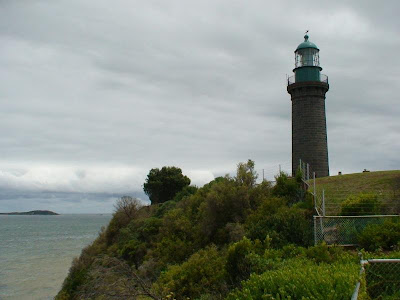
Queenscliff’s black stone lighthouse and distant Point Nepean
On a brooding day with scudding clouds and spitting sky, I felt the throb of the engines of the big ferry, Queenscliff, work in unison with the beat of my heart as I set out on my sea journey across the heads, to Sorrento. Alas, it was but for an hour, and I stood on deck amidships, sniffing the breeze stiffened with brine. Like quivering cleavage, the ferry dipped and shook as it crossed the Rip, but soon we were in the lee of the Mornington Peninsula, where the ‘millionaire’s row’ of mini-Newport mansions, hove into sight on the cliff-tops above Portsea. Tethered yachts, their bows nosing the breeze, sat neatly at the feet of colourful boat and bath houses, a scene daubed by artists the world over. Houses with big picture windows, and I imagined people with a coffee, or Scotch, watching our progress, and seeing beyond us, in the hazy distance, the just visible high rise of Melbourne, with its thrum.
Sorrento, like its namesake in Italy, has always been a favourite with the crowds. In the 1870’s, from a Melbourne still rich with gold, came George Coppin’s paddle steamers with a over a thousand on board, Scottish pipe bands, and gilded saloons, to picnic or to take the steam rail to the back beaches. Beaches such as the one near Portsea where an Australian Prime Minister, Harold Holt, went swimming in 1967, and simply vanished, although from time to time, he and Elvis are spotted having coffee together in various Victorian country towns! Over 150,000 came each summer, many just with picnic baskets and a thermos of tea, and the chance to dip feet in the calm water of the bay, before the 60 kilometre voyage home. Oh what a day’s outing it was!
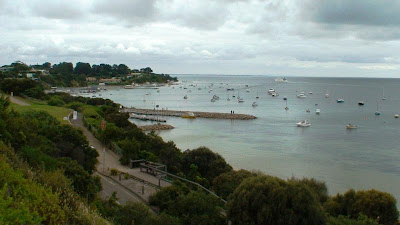
Sorrento bay as the ferry heads back to Queenscliff
Now Sorrento has been ‘hip’ and upper crusty, for many years, a place where Melburnians like to spend summer days in the little million dollar weekender, or given the chance, to bring over the Merc, and retire. As with so much of the coast, limestone is in abundance, and so is much of the architecture. The shops carry that rich mixture of chintzy, flaunty and tack, lots selling loose or flowing garments in cooling, blue or white, wine shops selling expensive bottles from obscure little wineries, real estate places oily with charm. I went in to Stringer’s Café, a shop with a delightfully disorderly collection of hand made jams beside hand painted bowls, and lovingly created biscuits, but also the best sausage rolls I ever tasted, and served by a young girl with a Marguerite daisy in her hair! Sipping excellent coffees, were bejeweled and heavily tanned biddies, with lots of blue eye-shadow, looking fresh from the set of Dynasty. Their Schnauzers and miniature Pugs, with their Rhinestone collars, were carefully tethered to veranda poles, just as a century ago, their pony traps might have been. The pace was simply slow astern.
I looked in art galleries and shops full of glass blown ‘things’, nothing that a few hundred dollars would not buy, the surf shops selling loud shirts and brief bikinis, as well as boards. The streetlights bent over, as though stooping, and there were discrete little road-signs to places with names like Rosebud , Mt Eliza and Cowes. On the Bay beach, full of the young and those closely watching the young, mothers all I dare say, kids dipped feet in the still waters, or clambered over clinker built boats, stranded ashore and looking like turtles. I reflected on ‘how young’ Australia actually is! The 1870’s seemed like ancient times, and yet that was only 140 years ago, when men would have sat here, in coats, trousers and a Boater hat, women in frills, watching the then young at play. My ferry approached and I made my way around the bay, the rotunda now silent and bare. A century ago it would have been alive with music, till the steam whistle from the Weeroona or the Ozone would have signaled the start of the end of the day. Then there would have been “aw shucks” packing and gathering. Now the ferry simply left on the hour. There was no longer a whistle or toot.
I caught the ferry Sorrento back to Queenscliff with the deck now a pleasanter spot, and so shared it with many travelers, their cars parked in the belly of the beast. Queenscliff is a pleasant town of 1500 residents, full of heritage buildings from its glory days in the 1880s when it was a premier seaside town, served by trains and paddle steamers from Melbourne. Its location was also integral to navigation into Port Phillip Bay and high and low water lighthouses were built, and the pilot service, begun in 1862, remains to this day. It was also a key to the defence of Melbourne so Fort Queenscliff was built in 1879 and modernized over the next fifty years. Ancient smooth bore cannon were replaced by more modern weaponry, including “disappearing guns” which disappeared back into their housing after firing a round. One such gun was refurbished in the 1980’s, and then before a gathering of dignitaries, was fired. Its ‘boom’ smashed every glass window in Fort Queenscliff (Then the Army Staff College) and many houses in the town suffered similar damage. The Army has solemnly promised that the gun will never be fired again!

The old C19 Ozone Hotel, with its views over the Heads
Queenscliff’s tourist boom ended at the turn of the twentieth century with the coming of the car, and the opportunity to travel beyond tourist hubs. The paddle steamer service stopped, and so did the rail service, although now on weekends, an ‘old belcher’ carries tourists on a local in-and-out run, just to show what life was like in the old soot and cinders days, and the smell of coal smoke again hangs in the air for oldies like me! The four or five grand hotels of old, still stand, some of them beautifully decorous of their glory days, such as the Queenscliff Hotel with its elegant entrance hall, bars and dining rooms. It was a place for assignations, for sylph and self, coming down the grand staircase arm-in-arm together, the delicate light from candles behind the coloured glass, saving blushes altogether! There are too, the pretty period cottages, all rose bedecked, and the streets of the town are still wide enough to permit the turning of a bullock dray or a coach and horses. The galleries and coffee shops are also back, and the quiet elegance of this time capsule of a town, has meant that the tourists are back in droves once more.
I wandered through Princess Park, past the local “Lutine Bell” – the Wreck Bell, which is only rung when a ship sinks, and then wandered up the gentle slopes of Gellibrand Street with its views of the Bay, and out to the Heads. And at the grassy top, I came to Fort Queenscliff, just as a tour group was entering, and I gladly mingled with them. Fort Queenscliff has the distinction of ordering the firing of the first shots in the world, after the declaration of WWI and II. In the First, a German merchantman did a runner for the open sea, and stopped after two shells were sent across her bows, and in the Second, a hapless Tasmanian freighter signaled “Hey it’s us” when shots were fired across its bow in a case of mistaken identity! Fort Queenscliff, which is still a functioning Army base, was the headquarters for an extensive chain of forts around the Port Phillip Heads. It is now one of Victoria’s most historic sites and the tour takes you into bunkers and firing positions, as well as right up to the black lighthouse and an earlier semaphore tower, which was integral to ships entering the Heads, in the early nineteenth century.
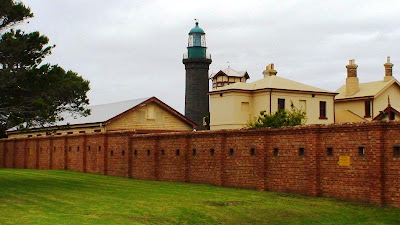
The grassed-in moat and the walls of Fort Queenscliff, signal tower and lighthouse
The 1959 film On The Beach, which dealt with the end of the world in a nuclear holocaust, had Melbourne as the last place of human habitation. Its closing scenes were shot at Barwon Heads, presumably the “last sight on earth” for the doomed submarine crew heading back to die in the nuclear devastated United States. Afterwards, Ava Gardner, allegedly said, “If you are making a film about the end of the world, then Melbourne is the right place to make it”. What a pity she did not see more of the Bellarine peninsula, and its beautiful countryside. Why, she might have come to like the place after all, even if it was the end of the world!
Winfred Peppinck is the Tales of the Traveling Editor for Wandering Educators
All photos courtesy and copyright Winfred Peppinck
-

- Log in to post comments

















